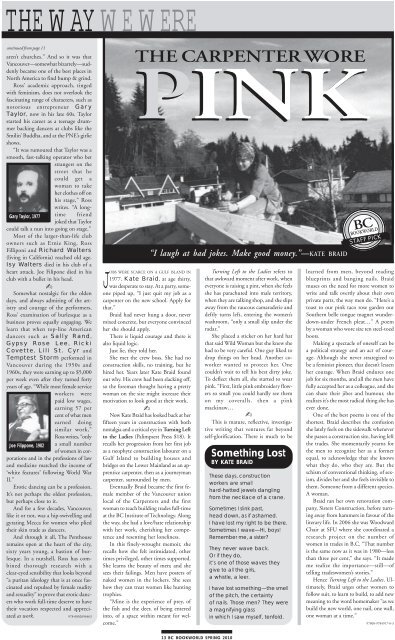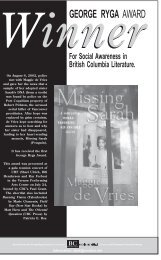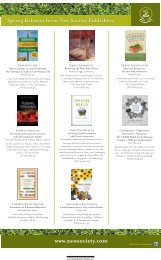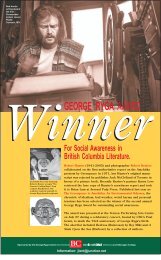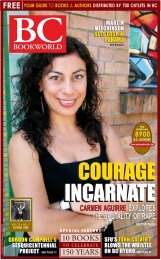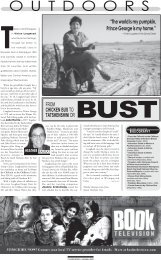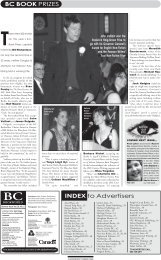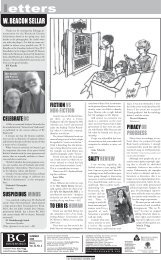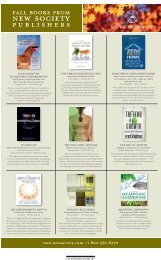2 BC BOOKWORLD SPRING 2010
2 BC BOOKWORLD SPRING 2010
2 BC BOOKWORLD SPRING 2010
- No tags were found...
Create successful ePaper yourself
Turn your PDF publications into a flip-book with our unique Google optimized e-Paper software.
13 <strong>BC</strong> <strong>BOOKWORLD</strong> <strong>SPRING</strong> <strong>2010</strong><br />
THE WAY WE WERE<br />
continued from page 11<br />
aren’t churches.” And so it was that<br />
Vancouver—somewhat bizarrely—suddenly<br />
became one of the best places in<br />
North America to find bump & grind.<br />
Ross’ academic approach, tinged<br />
with feminism, does not overlook the<br />
fascinating range of characters, such as<br />
notorious entrepreneur Gary<br />
Taylor, now in his late 60s. Taylor<br />
started his career as a teenage drummer<br />
backing dancers at clubs like the<br />
Smilin’ Buddha, and at the PNE’s girlie<br />
shows.<br />
“It was rumoured that Taylor was a<br />
smooth, fast-talking operator who bet<br />
strangers on the<br />
street that he<br />
could get a<br />
woman to take<br />
her clothes off on<br />
his stage,” Ross<br />
writes. “A longtime<br />
friend<br />
Gary Taylor, 1977<br />
joked that Taylor<br />
could talk a nun into going on stage.”<br />
Most of the larger-than-life club<br />
owners such as Ernie King, Ross<br />
Filliponi and Richard Walters<br />
(living in California) reached old age.<br />
Isy Walters died in his club of a<br />
heart attack. Joe Filipone died in his<br />
club with a bullet in his head.<br />
✍<br />
Somewhat nostalgic for the olden<br />
days, and always admiring of the artistry<br />
and courage of the performers,<br />
Ross’ examination of burlesque as a<br />
business proves equally engaging. We<br />
learn that when top-line American<br />
dancers such as Sally Rand,<br />
Gypsy Rose Lee, Ricki<br />
Covette, Lili St. Cyr and<br />
Temptest Storm performed in<br />
Vancouver during the 1950s and<br />
1960s, they were earning up to $5,000<br />
per week even after they turned forty<br />
years of age. “While most female service<br />
workers were<br />
paid low wages,<br />
earning 57 per<br />
cent of what men<br />
Joe Filippone, 1982<br />
earned doing<br />
similar work,”<br />
Ross writes, “only<br />
a small number<br />
of women in corporations<br />
and in the professions of law<br />
and medicine matched the income of<br />
‘white features’ following World War<br />
II.”<br />
Erotic dancing can be a profession.<br />
It’s not perhaps the oldest profession,<br />
but perhaps close to it.<br />
And for a few decades, Vancouver,<br />
like it or not, was a hip-swivelling and<br />
gyrating Mecca for women who plied<br />
their skin trade as dancers.<br />
And through it all, The Penthouse<br />
remains open at the heart of the city,<br />
sixty years young, a bastion of burlesque.<br />
In a nutshell, Ross has combined<br />
thorough research with a<br />
clear-eyed sensibility that looks beyond<br />
“a puritan ideology that is at once fascinated<br />
and repulsed by female nudity<br />
and sexuality” to prove that erotic dancers<br />
who work full-time deserve to have<br />
their vocation respected and appreciated<br />
as work. 978-0802096463<br />
THE CARPENTER WORE<br />
PINK<br />
JOBS WERE SCARCE ON A GULF ISLAND IN<br />
1977. Kate Braid, at age thirty,<br />
was desperate to stay. At a party, someone<br />
piped up, “I just quit my job as a<br />
carpenter on the new school. Apply for<br />
that.”<br />
Braid had never hung a door, never<br />
mixed concrete, but everyone convinced<br />
her she should apply.<br />
There is liquid courage and there is<br />
also liquid logic.<br />
Just lie, they told her.<br />
She met the crew boss. She had no<br />
construction skills, no training, but he<br />
hired her. Years later Kate Braid found<br />
out why. His crew had been slacking off,<br />
so the foreman thought having a pretty<br />
woman on the site might increase their<br />
motivation to look good at their work.<br />
✍<br />
Now Kate Braid has looked back at her<br />
fifteen years in construction with both<br />
nostalgia and a critical eye in Turning Left<br />
to the Ladies (Palimpsest Press $18). It<br />
recalls her progression from her first job<br />
as a neophyte construction labourer on a<br />
Gulf Island to building houses and<br />
bridges on the Lower Mainland as an apprentice<br />
carpenter, then as a journeyman<br />
carpenter, surrounded by men.<br />
Eventually Braid became the first female<br />
member of the Vancouver union<br />
local of the Carpenters and the first<br />
woman to teach building trades full-time<br />
at the <strong>BC</strong> Institute of Technology. Along<br />
the way, she had a love/hate relationship<br />
with her work, cherishing her competence<br />
and resenting her loneliness.<br />
In this finely-wrought memoir, she<br />
recalls how she felt intimidated, other<br />
times privileged, other times supported.<br />
She learns the beauty of men; and she<br />
sees their failings. Men have posters of<br />
naked women in the lockers. She sees<br />
how they can treat women like hunting<br />
trophies.<br />
“Mine is the experience of prey, of<br />
the fish and the deer, of being entered<br />
into, of a space within meant for welcome.”<br />
“I laugh at bad jokes. Make good money.”—KATE BRAID<br />
Turning Left to the Ladies refers to<br />
that awkward moment after work, when<br />
everyone is raising a pint, when she feels<br />
she has parachuted into male territory,<br />
when they are talking shop, and she slips<br />
away from the raucous camaraderie and<br />
deftly turns left, entering the women’s<br />
washroom, “only a small slip under the<br />
radar.”<br />
She placed a sticker on her hard hat<br />
that said Wild Woman but she knew she<br />
had to be very careful. One guy liked to<br />
drop things on her head. Another coworker<br />
wanted to protect her. One<br />
couldn’t wait to tell his best dirty joke.<br />
To deflect them all, she started to wear<br />
pink. “First, little pink embroidery flowers<br />
so small you could hardly see them<br />
on my coveralls. then a pink<br />
mackinaw…<br />
✍<br />
This is mature, reflective, investigative<br />
writing that ventures far beyond<br />
self-glorification. There is much to be<br />
Something Lost<br />
BY KATE BRAID<br />
These days, construction<br />
workers are small<br />
hard-hatted jewels dangling<br />
from the necklace of a crane.<br />
Sometimes I slink past,<br />
head down, as if ashamed.<br />
I have lost my right to be there.<br />
Sometimes I wave—Hi, boys!<br />
Remember me, a sister<br />
They never wave back.<br />
Or if they do,<br />
it’s one of those waves they<br />
give to all the girls,<br />
a whistle, a leer.<br />
I have lost something—the smell<br />
of the pitch, the certainty<br />
of nails. Those men They were<br />
a magnifying glass<br />
in which I saw myself, tenfold.<br />
<strong>BC</strong><br />
<strong>BOOKWORLD</strong><br />
STAFF PICK<br />
learned from men, beyond reading<br />
blueprints and banging nails. Braid<br />
muses on the need for more women to<br />
write and talk overtly about their own<br />
private parts, the way men do. “Here’s a<br />
toast to our pink taco rose garden our<br />
Southern belle tongue magnet wunderdown-under<br />
French pleat…” A poem<br />
by a woman who wore size ten steel-toed<br />
boots.<br />
Making a spectacle of oneself can be<br />
a political strategy and an act of courage.<br />
Although she never strategized to<br />
be a feminist pioneer, that doesn’t lessen<br />
her courage. When Braid endures one<br />
job for six months, and all the men have<br />
fully accepted her as a colleague, and she<br />
can share their jibes and humour, she<br />
realizes it’s the most radical thing she has<br />
ever done.<br />
One of the best poems is one of the<br />
shortest. Braid describes the confusion<br />
she lately feels on the sidewalk whenever<br />
she passes a construction site, having left<br />
the trades. She momentarily yearns for<br />
the men to recognize her as a former<br />
equal, to acknowledge that she knows<br />
what they do, who they are. But the<br />
schism of conventional thinking, of sexism,<br />
divides her and she feels invisible to<br />
them. Someone from a different species.<br />
A woman.<br />
Braid ran her own renovation company,<br />
Sisters Construction, before turning<br />
away from hammers in favour of the<br />
literary life. In 2006 she was Woodward<br />
Chair at SFU where she coordinated a<br />
research project on the number of<br />
women in trades in B.C. “That number<br />
is the same now as it was in 1980—less<br />
than three per cent,” she says. “It made<br />
me realize the importance—still—of<br />
telling tradeswomen’s stories.”<br />
Hence Turning Left to the Ladies. Ultimately,<br />
Braid urges other women to<br />
follow suit, to learn to build, to add new<br />
meaning to the word homemaker “as we<br />
build the new world, one nail, one wall,<br />
one woman at a time.”<br />
97800-9784917-0-3


